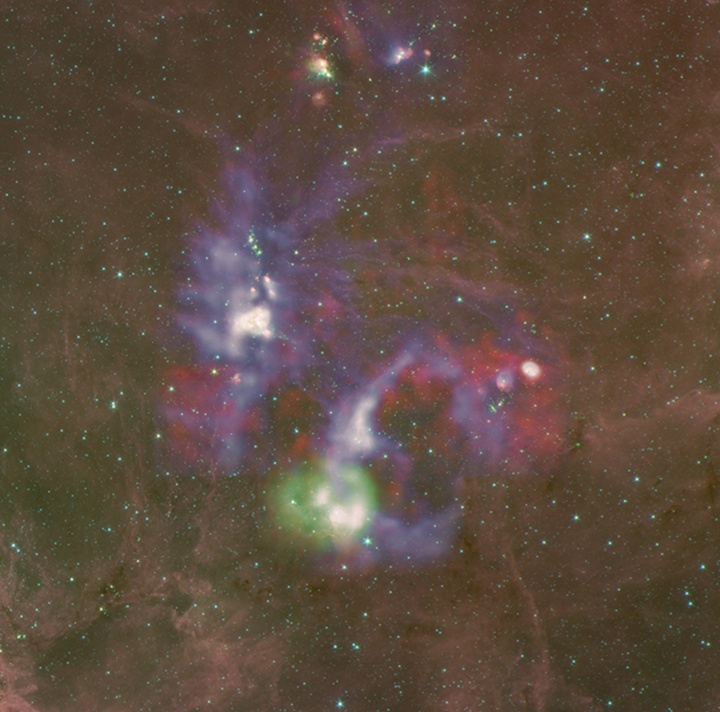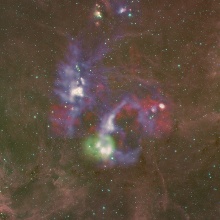Cygnus X is a vast region about 5,000 light-years from Earth, where new stars are constantly being formed from gas and dust. Exactly how this process works was not understood, until now. Based on observations made using the flying observatory SOFIA, an international team led by Nicola Schneider from the University of Cologne has now been able to show that in Cygnus X, gas clouds from which new stars ultimately form, are formed in just a few million years. In terms of astronomical timescales, this is fast, and contradicts the previous doctrine that this process is quasi-static and typically takes several hundred million years.
The new data from SOFIA also show that the high-velocity gas clouds in Cygnus X have a dense core of molecular hydrogen (H2) on the inside, surrounded by a shell of atomic hydrogen (H). These two regions interact with each other in a highly dynamic way, so that their outer shells collide at speeds of up to twenty kilometers per second. “This high velocity compresses the gas into denser, molecular regions where new, mainly high-mass stars form," explains Nicola Schneider.

Observation of Cygnus X was conducted as part of SOFIA's long-term international program FEEDBACK, led by Nicola Schneider and Alexander Tielens (University of Maryland). This program explored the main processes driving star formation and how these differ between different star-forming regions.
Because atomic hydrogen is difficult to detect in star-forming regions, researchers typically observe the spectral lines of ionized carbon (CII) at 158 microns, which is a reliable indicator of the presence of atomic hydrogen in interstellar gas. "We need the CII observations to detect this otherwise 'dark' gas," says Dr. Schneider. "Due to SOFIA and its sensitive instruments, we have now been able to measure this faint CII radiation from the edge of such a cloud for the first time."
SOFIA's observational data is important for fundamental research
After SOFIA ceased its observational operations at the end of September 2022, the data measured so far will be of great importance for fundamental astronomical research, because there is no other observatory capable of observing and mapping in the wavelength range between 30 and 300 micrometers. The now-operational James Webb Space Telescope observes in the infrared range at shorter wavelengths, down to 28 microns, and focuses on spatially small regions. "In the list of FEEDBACK sources observed so far, there are other gas clouds in various stages of development where we are now searching for weak CII radiation at the edges of the clouds in hope of detecting similar interactions to those seen in the Cygnus X region," says Schneider.
"The various long-term studies conducted by the SOFIA team that will provide future generations of astronomers with the most comprehensive and complete data sets possible in the far-infrared region. These can also be analyzed from various perspectives, and the scope of such research will reach far beyond SOFIA's actual operating time," says Bernhard Schulz, SOFIA Science Mission Operations Deputy Director from the German SOFIA Institute, which coordinates SOFIA's operations on the German side at the University of Stuttgart. "The SOFIA data archive will enable many more spectacular discoveries in the field of star formation and other astronomical research areas."
Original publication:
“Ionized carbon as a tracer for the assembly of interstellar clouds”, Nicola Schneider et al., February 16, 2023, nature astronomy
Further information about the publication:
- Astrophysics: Scientists Observe High-Speed Star Formation, press release from the University of Cologne, February 17, 2023
- FEEDBACK SOFIA C+ Legacy - Understanding the physical processes that regulate the feedback of massive stars on their environment
- FEEDBACK: a SOFIA Legacy Program to Study Stellar Feedback in Regions of Massive Star Formation, N. Schneider et al. 2020, Publications of the Astronomical Society of the Pacific, Volume 132, Number 1016
- GREAT - our far-infrared spectrometer platform on board SOFIA
About SOFIA
The Stratospheric Observatory for Infrared Astronomy (SOFIA) is a joint project of the Deutschen Zentrums für Luft- und Raumfahrt e.V. and the National Aeronautics and Space Administration (NASA). The project was initiated by the DLR, with funding from the German Federal Ministry of Economics and Climate Protection (BMWK) as the result of a resolution passed by the German Bundestag, and with funding from the state of Baden-Württemberg and the University of Stuttgart. SOFIAs activities are coordinated on the German side by the German Space Agency at DLR and carried out by the German SOFIA Institute (DSI) at the University of Stuttgart, and on the American side by NASA and the Universities Space Research Association (USRA). The development of the German instruments is funded by the Max Planck Society (MPG), the German Research Foundation (DFG) and DLR.


